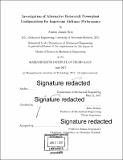| dc.contributor.advisor | John Brisson. | en_US |
| dc.contributor.author | Ritz, Austin James | en_US |
| dc.contributor.other | Massachusetts Institute of Technology. Department of Mechanical Engineering. | en_US |
| dc.date.accessioned | 2018-02-16T20:04:25Z | |
| dc.date.available | 2018-02-16T20:04:25Z | |
| dc.date.copyright | 2017 | en_US |
| dc.date.issued | 2017 | en_US |
| dc.identifier.uri | http://hdl.handle.net/1721.1/113753 | |
| dc.description | Thesis: S.M., Massachusetts Institute of Technology, Department of Mechanical Engineering, 2017. | en_US |
| dc.description | Cataloged from PDF version of thesis. | en_US |
| dc.description | Includes bibliographical references (pages 239-248). | en_US |
| dc.description.abstract | Alternative rotorcraft powerplant configurations were analyzed to determine their improvements to airframe performance capabilities, with the main goal of increasing an aircraft's range. The helicopter's engine was the focus of this thesis, with emphasis on improving its specific power (power vs weight ratio), efficiency, performance in high altitude and temperature, or capabilities during engine failure. Gas turbines, used in the majority of applications, were characterized through turboshaft databases, industry trends, and identifying changes to their operation and architecture at varying sizes. These results indicated that gas turbine performance capabilities are limited in low power class operation (i.e. small airframe sizes), providing the niche region where alternative engines have the potential for improvements. Standard gasoline and diesel piston engines, operating in both four- and two- stroke modes, were considered as alternative configurations and were evaluated using industry trends and example engine data. Additionally, the two/four-stroke switching gasoline engine (changing operation mode between two- and four-stroke) was used to achieve higher specific powers, with simulations suggesting substantial improvements. Flight profile modeling was conducted using a variety of airframes, created using industry standard practices. The identified engines were conceptually implemented in the aircraft through standard engine swaps replacing the gas turbines with piston engines, hybrid designs incorporating both a gas turbine and piston engine, and auxiliary engine configurations that include a small gas turbine in addition to the main gas turbine or piston engine(s). Equipped with each design, the aircraft were simulated as conducting a characteristic flight path, providing a comparison in performance. Based on these results, the standard, hybrid, and auxiliary two/four-stroke engine, auxiliary diesel two-stroke design, and auxiliary gas turbine configuration provided significant improvements in range at various airframe sizes, with a maximum increase of 49%. | en_US |
| dc.description.statementofresponsibility | by Austin James Ritz. | en_US |
| dc.format.extent | 248 pages | en_US |
| dc.language.iso | eng | en_US |
| dc.publisher | Massachusetts Institute of Technology | en_US |
| dc.rights | MIT theses are protected by copyright. They may be viewed, downloaded, or printed from this source but further reproduction or distribution in any format is prohibited without written permission. | en_US |
| dc.rights.uri | http://dspace.mit.edu/handle/1721.1/7582 | en_US |
| dc.subject | Mechanical Engineering. | en_US |
| dc.title | Investigation of alternative rotorcraft powerplant configurations for improving airframe performance | en_US |
| dc.type | Thesis | en_US |
| dc.description.degree | S.M. | en_US |
| dc.contributor.department | Massachusetts Institute of Technology. Department of Mechanical Engineering | |
| dc.identifier.oclc | 1021886086 | en_US |
